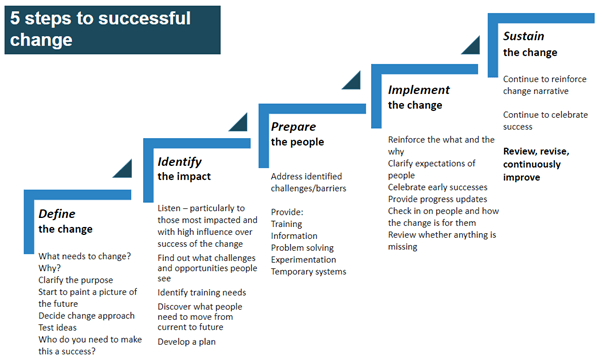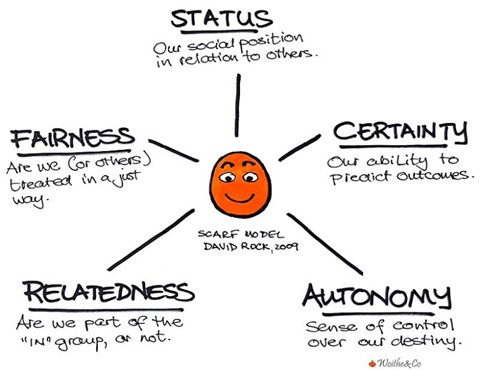‘Change’ seems to be the word of the day, every day – change is part of everyday life and work. Humans must adapt to survive, and so must universities. But that doesn’t mean it’s easy. The dream is to manage change so well that it becomes part of the day job, and we’re so comfortable with it that we don’t even notice that change is happening. But how realistic is that? The familiar sense of ‘change fatigue’ comes not always from too much change, but from change that isn’t done well.
What does the University do to manage change?
Aiming to ensure that change is done well is the University’s Change Management Team. The team comprises professionally-accredited Change Managers working to support change across the University by preparing people to deliver the University’s ambitions. The team has developed its own model for managing change, with the intention of getting it used across the University by everyone leading and managing change, whether it be a relatively small local change or a large strategic initiative. The framework, which is simply called ‘5 Steps to Successful Change’, puts the University ahead of most within the Higher Education sector.
By following the ‘5 steps’ we take the impact on people into account, and adequately plan for change, thereby ensuring that people retain a sense of control over what is happening and can play their part in long term successful change. It necessitates those leading change to really interrogate the reasons for change, so that they can speak about change honestly and consistently, and in a way that is meaningful to those impacted. The ‘5 Steps’ also helps to ensure as much as possible that people can maintain their day-to-day work during times of change.

To facilitate successful use of the ‘5 step’ model, the Change Team operates as business partners. Whilst a consistent approach to change is essential, it also needs to be contextualized, and by working as partners with each Faculty and Division, the Change Managers can tailor the approach to change to consider what is unique about each part of the University and advise on planning for change accordingly.
Why is change so difficult?
If there is a team dedicated to managing change, and it has a sector leading approach, why then does change appear to be so hard to do well? To a certain extent, change will always be difficult, particularly in an organisation the size of the University, with multiple cultures at play, and concurrent initiatives requiring many people to play a part in change. Most significantly, change is difficult because of the factor of human emotion. Remaining in our comfort zones is a safer place to be, requiring less energy and threat, meaning that it is normal to desire to move away from change.
The reality of change either posing threat or reward is something that the Change Team talk about in change management workshops, which run regularly for academic and professional services colleagues. If we consider a change that we have felt uncomfortable with, it’s likely that it has posed some threat to us. David Rock’s SCARF model identifies five key factors that impact the extent to which we feel threatened or rewarded by a change. It provides interesting insights into why we may feel differently about certain changes than others, and how these manifest in our reactions to change.

Change fatigued?
To return to the notion of ‘change fatigue’, change is tiring, and it impacts people differently from one individual to the next depending on their history of change, what else is going on for them at the same time, and the extent to which they are either threatened or rewarded by it. Change requires us to psychologically process the change before we can fully move with it, and this alone is tiring, even without having to continue with our day jobs and personal lives at the same time. The extent to which we feel a sense of influence or control over the change is also a key factor. Whilst we may not have ultimate control over whether a change happens, if we can feel a sense of control by understanding the true reasons for change, feeling well informed and understanding what’s expected of us (the first step in the 5 Steps to Successful Change), then that all helps to lessen the sense of fatigue and equip people with the energy to change.
So, whilst we must accept that we must adapt to survive and that change will usually be difficult, by following the ‘5 Steps to Successful Change’, we can set ourselves up to manage change in a way which stands the greatest chance of success with minimal negative impact on people.
Contact the Change Team

Please contact change-team@bristol.ac.uk to find out how the Change Team can support change in your part of the University.
